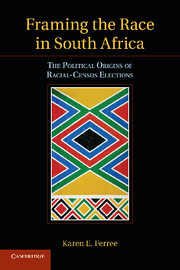Book contents
- Frontmatter
- Contents
- List of Tables
- Acknowledgments
- 1 Introduction
- 2 Voters
- 3 The 1994 Campaigns
- 4 The 1999 Campaigns
- 5 The 2004 Campaigns
- 6 Can a Leopard Change Its Spots? Candidate Demographics and Party Label Change
- 7 Why So Slow? The Political Challenges of Candidate Transformation for Opposition Parties
- 8 Negative Framing Strategies and African Opposition Parties
- 9 Conclusion: South Africa in Comparative Perspective
- References
- Index
- Titles in the series
2 - Voters
Published online by Cambridge University Press: 06 December 2010
- Frontmatter
- Contents
- List of Tables
- Acknowledgments
- 1 Introduction
- 2 Voters
- 3 The 1994 Campaigns
- 4 The 1999 Campaigns
- 5 The 2004 Campaigns
- 6 Can a Leopard Change Its Spots? Candidate Demographics and Party Label Change
- 7 Why So Slow? The Political Challenges of Candidate Transformation for Opposition Parties
- 8 Negative Framing Strategies and African Opposition Parties
- 9 Conclusion: South Africa in Comparative Perspective
- References
- Index
- Titles in the series
Summary
Census elections like those in South Africa reflect the decisions of millions of individual voters. To understand the origins of the census, we must therefore begin with an exploration of individual-level voting behavior. The question can be framed as this: When an African voter chooses the African National Congress (ANC) over one of its “white” competitors (the New National Party or the Democratic Alliance), what explains her behavior? Is it the need to express her identity as an African? Is it general antipathy to whites and the parties that represent them? Or are her motivations more instrumental, a function of policy preferences and performance evaluations? If they are instrumental, what role, if any, does race play? And, perhaps most importantly, how do these factors interact with one another?
In addressing these questions, this chapter distills and tests three hypotheses from the general voting literature. The first hypothesis (“expressive voting”) holds that racial voting results as voters use the ballot box to express their identities as members of racial groups. The second hypothesis (“politics-as-usual”) explains racial voting through nonracial factors. It suggests that racial voters, like all voters, care what governments do and how well they do it. Convergence of voting behavior within racial groups occurs because group members share common policy preferences and performance evaluations – not a common identity. The third hypothesis (“racial heuristics”) shares the instrumentalism of the second but gives race a more active role in explaining behavior.
- Type
- Chapter
- Information
- Framing the Race in South AfricaThe Political Origins of Racial Census Elections, pp. 32 - 64Publisher: Cambridge University PressPrint publication year: 2010

